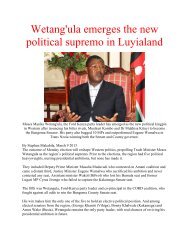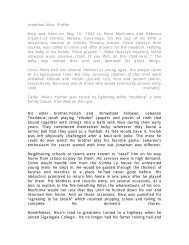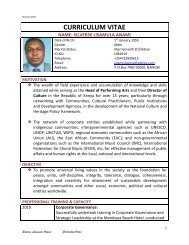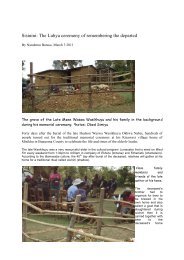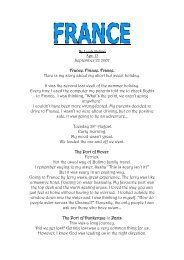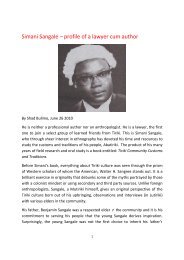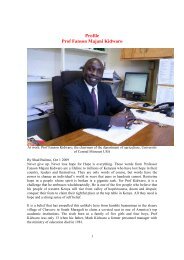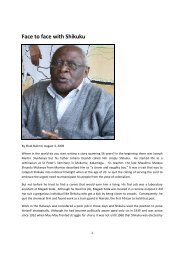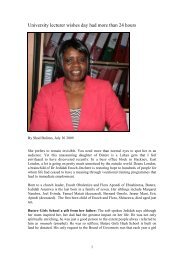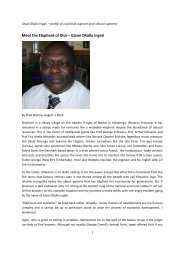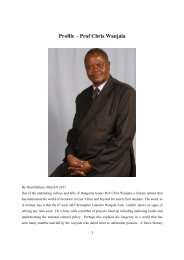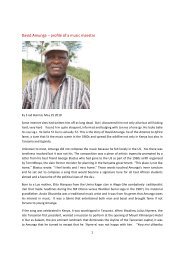Abasonga The Aberecheya clan Though there are some ...
Abasonga The Aberecheya clan Though there are some ...
Abasonga The Aberecheya clan Though there are some ...
Create successful ePaper yourself
Turn your PDF publications into a flip-book with our unique Google optimized e-Paper software.
<strong>Abasonga</strong><br />
<strong>The</strong> <strong>Aberecheya</strong> <strong>clan</strong><br />
<strong>Though</strong> <strong>there</strong> <strong>are</strong> <strong>some</strong> inconsistencies in the traditions of the <strong>Aberecheya</strong> regarding their<br />
ancestor and his original country, <strong>there</strong> is a unanimous opinion on the rest of their history.<br />
During my investigations in this <strong>are</strong>a the one man who was repeatedly mentioned as the<br />
authority on the early history of the <strong>Aberecheya</strong> was Sumba Okumu. Fortunately, I was<br />
in possession of the narrative of the history of the <strong>Aberecheya</strong> which had been recorded<br />
earlier by the Regeya Progressive Society. As what he told me was exactly the same as<br />
the recorded material, I shall here give a translation of the latter and then go on with the<br />
other versions.<br />
“Kusesechere son of Sumba came from the Bagweri who live at Soroti (actually the<br />
Bagwere live at Mbale) in Teso in Uganda. His first settlement was at Jinja among the<br />
Basoga where he begot a son called Musoga who became the ancestor of the Abasoga.<br />
When he migrated from Busoga he settled at Busia where he had a son called Samia who<br />
became the ancestor of the Abasamia. <strong>The</strong>n he moved on once more to Ebusinga where<br />
he built a home called Mundika.<br />
He had a son <strong>there</strong> called Musonga, the ancestor of the <strong>Abasonga</strong>. Afterwards he went to<br />
Ebusenge which is in Yimbo Kadimo. When he saw that <strong>there</strong> was plenty of water, he<br />
moved on to Kanyabol which is now called Lake Gangu. From <strong>there</strong> he went to Mbaga<br />
where he had a son who became the ancestor of the people now called Luo Kamenya.<br />
Later he left Mbaga and came to Ndere Gem where the Gem man called Rading’ found<br />
him living. <strong>The</strong> language of Rading’ was different from the one which Kusesechere<br />
spoke. When Kusesechere later left Ndere he came to Ebukwala Murumba. By this time<br />
Wabuti had grown up sons who now dispersed and built separate homes: Wabuti himself<br />
and his sons Wambundo, Lwari, Nandera and Omuhandasi went to the Irecheya hill<br />
whereas Shibashe crossed the Isika River and settled at Manyala. Wabuti had two wives.<br />
His first wife was the mother of Wambundo; the younger one was the mother of Lwali,<br />
Nandera (twins), Shibashe and Omuhandasi.”<br />
According to Yona Renja the ancestors of the <strong>Aberecheya</strong> came from Eshifuyo in Samia.<br />
<strong>The</strong> people who lived at Eshifuyo were Abasamia and the ancestor of the <strong>Aberecheya</strong> at<br />
Eshifuyo was called Shiruka. He was a member of the Abagwere sub-tribe. His son<br />
Sumba was the leader of the emigration from Eshifuyo. His great grandson, Wabuti, was<br />
the immediate ancestor of the <strong>Aberecheya</strong>; he was the son of Kusesechere. Gerishom<br />
Ongawo also says that Samia was the original country of the <strong>Aberecheya</strong>; Wabuti was the<br />
founder of the <strong>clan</strong>.<br />
On the other hand Nyangule Wesonga merely says that the ancestors of the <strong>Aberecheya</strong><br />
came from Buganda; however, he adds in the genealogies that one of the sons of Regeya<br />
who was, according to him, their ancestor was called Mugwer and that he remained in<br />
Buganda, which seems to tally with the other traditions of a Bagwere origin. <strong>The</strong> rest of<br />
the details regarding the migrational movements <strong>are</strong> as narrated by Sumba.
People they met along the way:<br />
Bugwere and Busoga: Unknown.<br />
Samia: <strong>The</strong> Abasamia.<br />
Manyala Mundika and Ebusonga: Uninhabited.<br />
Gendero (near Lake Gangu): <strong>The</strong> Abanyaudo; they were Abaluyia.<br />
Ebusenge (Yimbo Kadimo): <strong>The</strong>y found here Owiny the brother of Adhola; <strong>The</strong>y were<br />
Padhola.<br />
Ndere Gem: <strong>The</strong> Abamakonje, Abamuswa, and the Abamukonyi. <strong>The</strong>y were all<br />
Abaluyia. <strong>The</strong> ruler of the Gem people found Kusesechere (Wabuti) here; they failed to<br />
get on well owing to linguistic differences. As a result, Kusesechere migrated to<br />
Ebukwala from where he went to the Irecheya hill.<br />
Murumba: <strong>The</strong> Abamuswa.<br />
Ebukwala: <strong>The</strong> Abamutsuma.<br />
Manyala, Eshihenjera, Mukokwa, Elukanji, and Ebukhokoro: were all uninhabited.<br />
Sanjiro: Kanyakuta Luo and the Abamani who were Abaluyia.<br />
Irecheya hill and the surrounding district: <strong>The</strong> Abekhole and the Abamukhone. Both<br />
were Abaluyia and they also came from the same place as the <strong>Aberecheya</strong>. <strong>The</strong>y<br />
gradually intermixed and became one people.<br />
<strong>The</strong>ir emigration from Bugwere<br />
Kusesechere emigrated from Bugwere as a result of a disagreement with his brother over<br />
a spear. It so happened that as Kusesechere was one day in his home; he saw an elephant<br />
eating his potato vines. He <strong>there</strong>fore took a spear and threw it at the elephant. <strong>The</strong><br />
elephant, however, walked away and disappe<strong>are</strong>d with the spear in its side. Now it so<br />
happened that the spear belonged to the brother of Kusesechere.<br />
When <strong>there</strong>fore the brother returned home, he asked for his spear and, when Kusesechere<br />
told him what had taken place, he insisted on the recovery of his spear. He rejected<br />
Kusesechere offer of a compensation which included, among other things, a number of<br />
spears. This kind of behaviour astonished Kusesechere who kept on appealing to his<br />
brother to be more understanding as everything had been accidental. However, his<br />
brother remained obdurate.<br />
In the face of all this, Kusesechere decided to go out and look for the wounded elephant<br />
so that he might recover his brother’s spear. Accordingly, he prep<strong>are</strong>d everything for the<br />
journey. <strong>The</strong> following morning he set out on the hazardous journey which took him right<br />
into the wilderness. Eventually, he arrived at the place<br />
where the elephants dwelt. He found the elephants drinking <strong>some</strong> beer.<br />
Frightened and dismayed, he stood in the court-yard and supported himself on his staff.<br />
Soon the elephants became aw<strong>are</strong> of his presence and one of them asked him what his<br />
mission was, saying, “what does this upright being want here?” After his explanation he<br />
was immediately led to a place where <strong>there</strong> were many spears. He soon identified his<br />
brother’s spear and, also, the elephant which he had wounded. He was then pardoned<br />
warned, and given his spear together with <strong>some</strong> food and told to go back. When he<br />
reached home, he gave his brother the recovered spear.
He then thought it best for him to part with his brother and migrate.<br />
<strong>The</strong> migration from the Irecheya hill<br />
<strong>The</strong>ir departure from the hill spread over many years. <strong>The</strong>ir loss of that hill was due to<br />
the wars between Mumia and the Abageri (Kager Luo). Sande who was the ruler of the<br />
Abakami (Gem Luo) at that time allied with the Abageri against the people of Mumia. At<br />
that time the <strong>Aberecheya</strong> were still in possession of the hill. <strong>The</strong>n the Kager and the Gem<br />
Luo drove the <strong>Aberecheya</strong>, Abamarama, and the Abashieni as far as maya. Mumia then<br />
brought the Swahili with fire-arms against them However, the<br />
Kager fought bravely and drove them away.<br />
<strong>The</strong>re then followed a short period of peace. After that Mumia brought Hobilo’6 who<br />
succeeded in driving the Abageri (Kager) out of the lands they had wrested from their<br />
enemies. And so the Abageri were dispersed and scattered to the four winds. <strong>The</strong>n the<br />
people of Mumia - the Abashieni, the Abamarama, and the <strong>Aberecheya</strong> returned to their<br />
former territories. Later, the Kager trickled back; whenever anyone gave his daughter to<br />
Shiundu he was allowed to come back. At that time the Kager were still<br />
one united sub-tribe28. Among the Kagér of Manyala Odhoji was the first to come back<br />
after he had given his daughter to Shitechi, Shiundü’s son. <strong>The</strong> other Kager then<br />
gradually came back.<br />
When Sande saw all this he went and persuaded Mumia to end fighting. He fe<strong>are</strong>d that<br />
his people of Gem might be driven out like the Kager people had been by Mumia’s<br />
people. And so Mumia agreed and “cut a dog” (a ceremony that symbolises end of<br />
hostilities) with him at Ebutamanyi and a cow was also slaughtered and both he and<br />
Sande lay on its skin to symbolise friendship. <strong>The</strong>n they undertook to cease fighting and<br />
began to draw their common boundary. Mumia wished the boundary to pass through the<br />
Khasala River. <strong>The</strong>n Mr. Archer (Asha) stood on the Irecheya hill and pointed at a certain<br />
fig tree at Eshirotsa near Yala and said that the boundary should run from that tree down<br />
to the Khasala river; the hill was thus placed on this side of the border and not in Gem.<br />
However, the ruler of the Abasamia (Kisa) called Limiku and Nyangule son of<br />
Wamukobole of the Abamarama <strong>clan</strong> later went and cut down the fig tree because they<br />
wished the boundary to pass through Emaliera so that their people might live on this side<br />
of the border. This annoyed Archer who <strong>there</strong>fore decided to move the boundary back to<br />
the River Isika as a punitive act against the people of Mumia. <strong>The</strong>n Obanda and the<br />
<strong>Aberecheya</strong> who were living on the hill refused to live with the Luo and so came this way<br />
among their brethren and fellow Abaluyia. And so the Gem Luo gradually occupied the<br />
hill.<br />
Genealogies<br />
Sumba Okumu is the son of Okumu son of Sumba; son of Shihwawa son of Wadida; son<br />
of Nyandera; son of Kisoni; son of Kusesechere son of Sumba. Nyangule Wesonga is the<br />
son of Wesonga son of Ndalo; son of Wakhabale son of Omunyobi; son of Sumba; they<br />
all died here; Sumba was the son of Okumu; son of Sumba; son of Watita; they all died at
Gendero near Lake Gangu; son of Wekolia who died at Munanga; son of Makabira who<br />
died at Khuluche near Manyala; son of Regeya who died on the Irecheya hill.<br />
Girishom Ongawo is the son of Omurambi; son of Wasendwa; son of Shirulu; son of<br />
Wambundo; son of Shibashe; son of Wabuti. Yona Renja is the son of Ong’ongo<br />
who died at Manyala; son of Wekoto who died at Shiatsala; son of Eroba who died at<br />
Manyala; son of Washiruma who died at Manyala; son of Wamboko who died on the<br />
Irecheya hill; son of Wamukhone who also died <strong>there</strong>; son of Olwanda who died at<br />
Manyala; son of Wamukhole who died at Mundere; son of Regeya who died at Mundere;<br />
son of Kusesechere; (son of Regeya ?); son of Sumba; son of Shiruka. Shiruka died at<br />
Eshifuyo and Sumba died at Gendero near Lake Gangu. Petero Owala is the son of<br />
Owala; son of Shisia; son of Shiwani; son of Maloba; son of Lukhale; son of Shibashe;<br />
son of Lulikho; son of Regeya (Wabuti); son of Kusesechere; son of Muruka; son of<br />
Podho.



